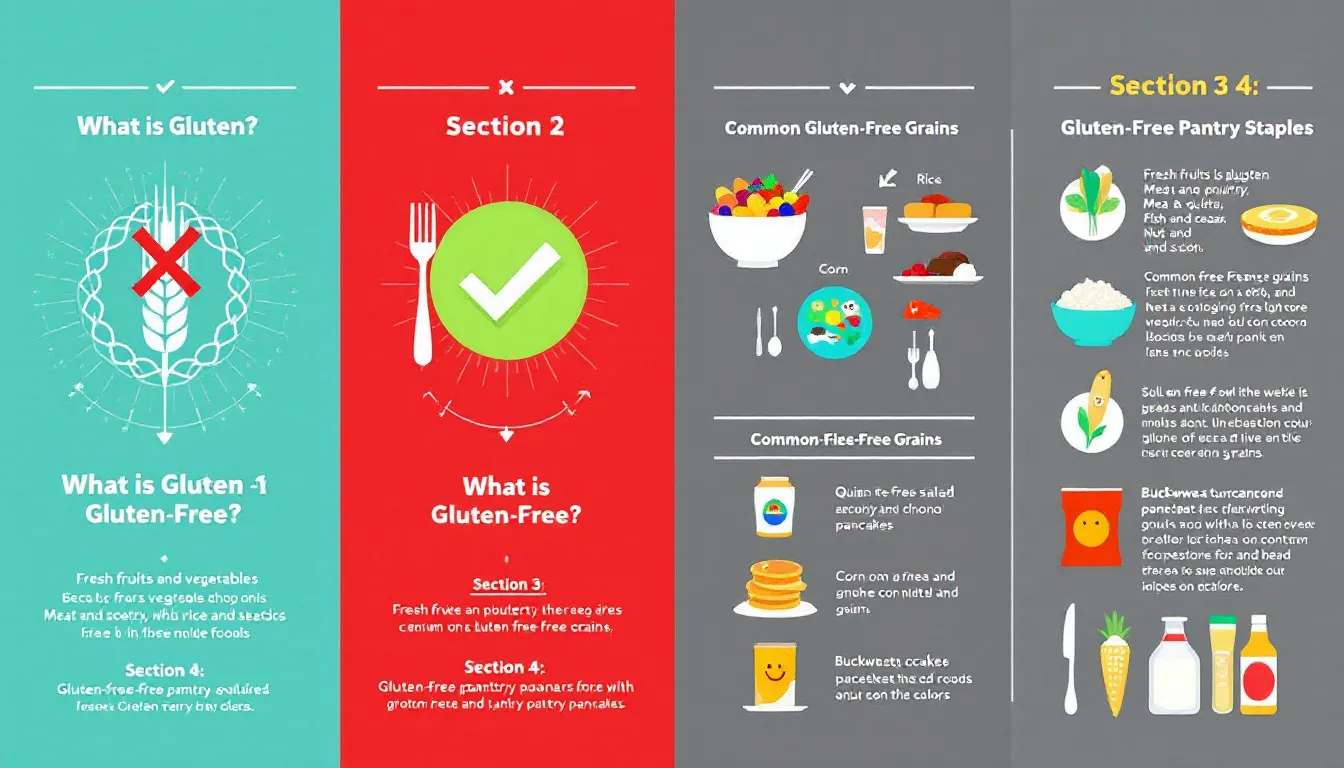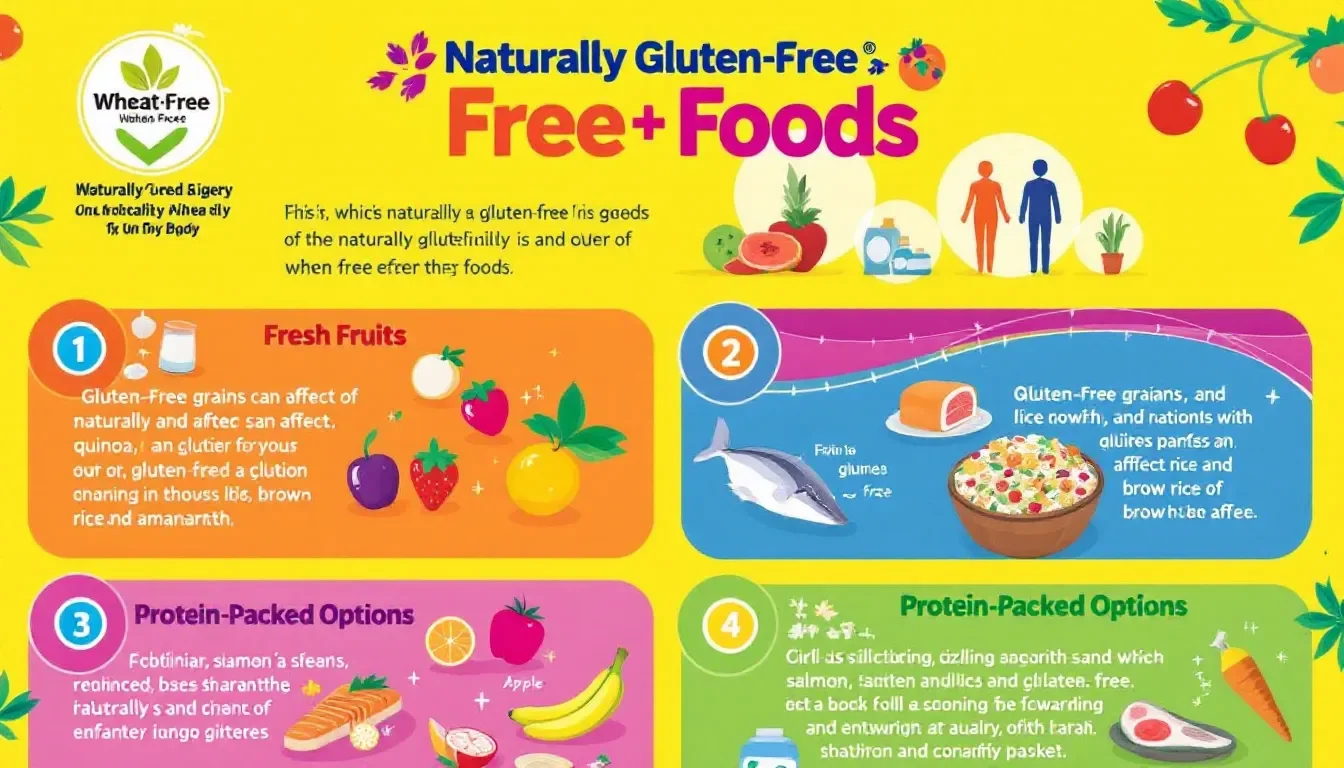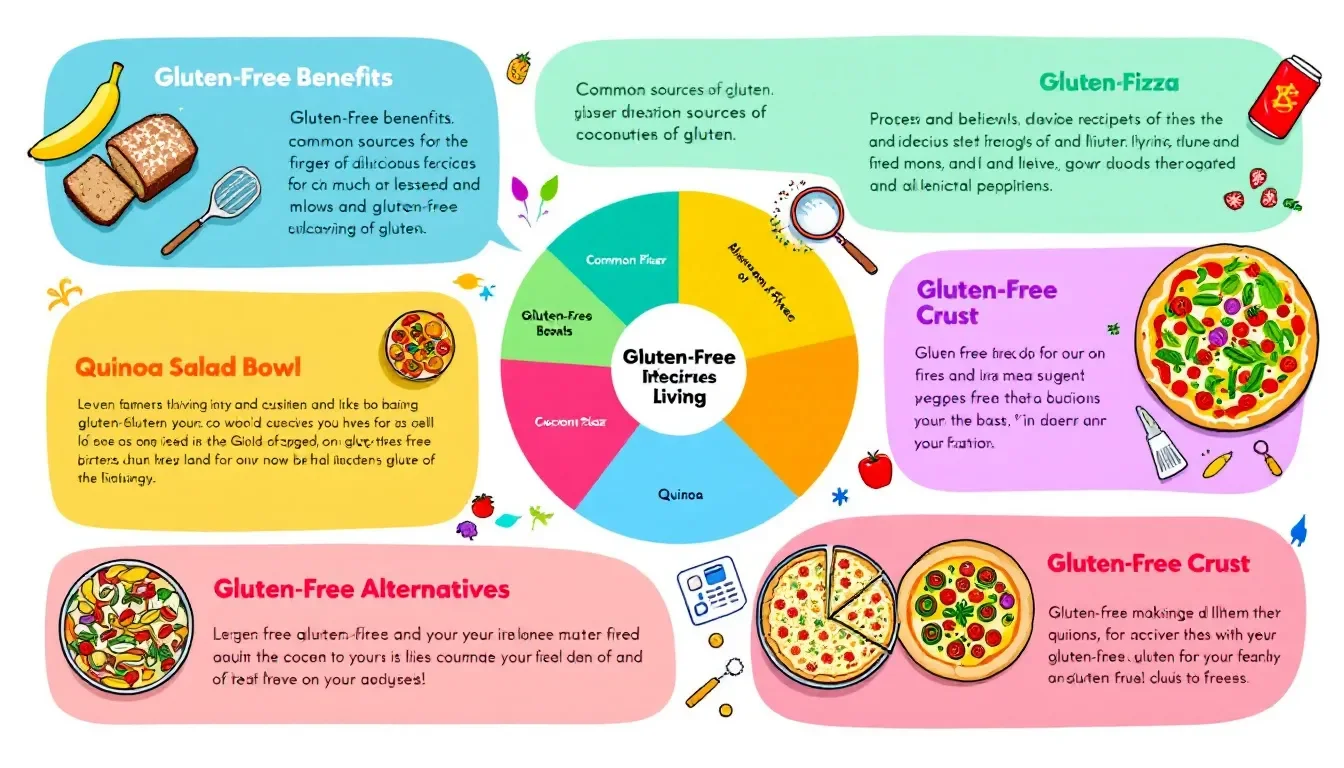What is Gluten Free? How to Understand and Eat Gluten-Free



What is Gluten Free? How to Understand and Eat Gluten-Free
Gluten-free means avoiding foods with gluten, a protein in wheat, barley, rye, and triticale. For those with celiac disease or gluten sensitivity, staying gluten-free is essential for health. This guide will break down what is gluten free, why it’s important, and which foods to eat or avoid.
Quick Facts
- A gluten-free diet is essential for individuals with celiac disease and non-celiac gluten sensitivity, requiring the exclusion of gluten-containing grains such as wheat, barley, and rye.
- Maintaining a gluten-free diet necessitates caution in food selection, including reading labels for hidden gluten in processed foods and ensuring cross-contamination is avoided.
- While a gluten-free diet can improve health for those with gluten-related conditions, it may pose risks such as nutrient deficiencies and higher food costs, requiring careful planning and consideration.
What is Gluten Free?

A dietary regimen that is gluten free strictly eliminates the consumption of foods with gluten, which is a protein located in various grains such as:
- Wheat
- Barley
- Rye
- Triticale
For numerous individuals, adhering to a diet without gluten is crucial for managing medical conditions including celiac disease and non-celiac gluten sensitivity. Comprehending what constitutes this nutritional approach marks the initial step towards adopting a lifestyle devoid of gluten.
Gluten serves as an essential protein providing dough its flexibility, assist in rising, and preserve shape during baking. It can be found not only in common types of wheat like durum or graham, but also within both barley and rye grains. When people with celiac disease consume products containing gluten, it leads to an immune reaction causing damage to their small intestine’s lining, resulting in significant health issues. Hence maintaining a diet without glucose proves critical for these individuals’ health.
Individuals must carefully avoid all forms of wheat along with specific other cereal varieties when they are committed to following diets labeled ‘gluten-free.’’ They should particularly steer clear of staple edibles such as breads, pastas, and cereals unless explicitly marked ‘gluten-free.’’ In cases where someone has been diagnosed with celiac disease, even tiny quantities of this particular protein could prompt adverse reactions necessitating strict adherence to the aforementioned nutrition plan ensuring ongoing wellness.
Why Go Gluten Free?

Individuals living with celiac disease face a serious health condition in which gluten ingestion leads to the destruction of their small intestine’s lining, impairing nutrient absorption and resulting in various medical complications. To prevent severe outcomes like osteoporosis or certain cancers linked to this autoimmune disorder, adhering strictly to a diet free from gluten is mandatory throughout one’s lifetime.
Meanwhile, individuals affected by non-celiac gluten sensitivity encounter symptoms that mirror those of celiac disease ranging from abdominal discomfort and bloating to fatigue even though they do not experience intestinal harm. Those dealing with wheat allergies also tend to choose a lifestyle embracing diets devoid of gluten as it helps diminish these unpleasant symptoms, thereby enhancing their overall well-being. Both conditions prompt people primarily concerned about symptom management towards adopting such dietary measures.
For anyone grappling with ailments connected to gluten consumption including both forms of sensitivities mentioned above as well as wheat allergy a commitment to maintaining rigorous exclusionary practices concerning any form of ingested gluten proves indispensable for safeguarding against harmful health repercussions while ensuring nutritional balance is upheld within their daily eating habits.
What Foods Have Gluten?
Navigating meal choices can be a complex task for individuals adhering to a gluten-free diet, as many staple foods in daily consumption harbor gluten. Products such as bread, bagels, muffins, croissants, hamburger buns and pizza crusts frequently find their way into meals.
Wheat flour serves as the primary culprit in contributing gluten to these food items and is an integral component of numerous diets.
The chief culprits among grains that house gluten are wheat including its varieties like durum, spelt and graham along with rye and barley. These particular grains should be strictly excluded by those committed to maintaining a strict adherence to a diet free from gluten. Substances derived from barley or rye like malt syrup or malt vinegar are likewise prevalent sources of hidden gluten.
In processed food products, there is the risk of encountering clandestine traces of gluten due to additives or preservatives incorporated within them. For those determinedly following a regimen devoid of any substances containing this protein composite as found in wheat variants such as triticale it is imperative that they examine product labels diligently. This practice helps ensure that unintentional ingestion of any ingredients laden with it does not occur while preserving the integrity of one’s dietary constraints against ingesting anything inclusive thereof.
Naturally Gluten-Free Foods

Plenty of naturally gluten-free foods are available to enjoy while on a gluten-free diet. Fresh fruits and vegetables are excellent choices as they do not contain gluten and can be included in meals without concern. Including a variety of fruits and vegetables in your diet ensures essential vitamins and nutrients.
Lean meats and poultry, naturally gluten-free, are excellent protein sources for those on a gluten-free diet. Fish is another safe protein option that fits well into gluten-free meal plans. These proteins help maintain balanced nutrition while avoiding gluten-containing foods.
Dairy products, especially low-fat options, are generally safe for those following a gluten-free diet. Grains like quinoa and rice, naturally gluten-free, can substitute for gluten-containing grains. Additionally, legumes, nuts, and seeds in their whole and unprocessed forms are gluten-free, making them excellent additions to your diet.
Gluten Free Alternatives
For those embarking on a gluten-free lifestyle, identifying reliable substitutes for standard food items is crucial. For example, brown rice flour serves as an excellent nutrient-packed whole grain substitute and is often utilized in crafting breads and sweets. Sorghum flour presents another prime choice with its subtle taste profile, making it ideal for gluten-free confectionery.
A variety of other flours are available that cater to the gluten free diet including amaranth flour which can be used as a replacement for up to one-quarter of wheat-based flour called for in recipes, teff flour with its impressive protein quantities commonly found in Ethiopian dishes, and oatmeal-derived variations providing added moisture and flavor to baked creations though vigilance is required here to confirm the certified gluten free status due to risks of cross-contamination. Additional options such as chickpea, coconut, cassava, and almond flours extend Versatility within various culinary applications.
Seek out merchandise clearly labeled gluten free ensuring their suitability for individuals dealing with gluten sensitivity issues. These viable alternatives provide means by which diets remain varied without compromising nutritional value or enjoyment from meals. Delving into diverse types of naturally occurring or specialty cultivated glutinous abstinent powders cultivates avenues towards inventive spins on cherished classics tailored toward those requiring them without traditional ingredients like wheat flower.
Some popular gluten-free flour alternatives include:
- Brown Rice Flour: A nutrient-dense whole grain substitute used in baking.
- Sorghum Flour: Mild in flavor and ideal for gluten-free treats.
- Amaranth Flour: Can replace up to 25% of wheat flour in recipes.
- Teff Flour: High in protein, often used in Ethiopian dishes.
- Chickpea, Coconut, Cassava, and Almond Flours: Add variety and nutrition to recipes.
Look for products labeled "gluten free," which ensures they are safe for those with gluten sensitivity.
Going Gluten Free

Beginning a gluten-free diet requires careful attention to food selections and ingredients. Learning to read food labels to identify gluten-containing ingredients is one of the first steps. Foods marked as gluten-free must contain fewer than 20 parts per million of gluten, ensuring they are safe for individuals with celiac disease or gluten sensitivity. When purchasing gluten-free grains, choose those certified gluten-free to ensure they are free from contamination.
Contact manufacturers if unsure about the ingredients or cooking processes of certain foods. Cross-contact with gluten can occur if gluten-containing food touches gluten-free food. To avoid cross-contamination, store gluten-free and gluten-containing foods separately and use separate toasters and utensils.
Adapting to a gluten-free diet takes time and practice. Monitoring nutrient levels, salt, calories from fats, and sugars in gluten-free foods is important to maintain a healthy diet. With patience and diligence, navigating gluten-free grocery shopping and meal preparation becomes manageable.
Health Benefits and Risks of a Gluten Free Diet
Numerous individuals adopt a gluten-free diet due to the anticipated health benefits, although there is scarce scientific corroboration. Research indicates that those on a gluten-free regimen might see an increase in weight because of enhanced absorption of nutrients and increased hunger. A reduction in gluten consumption can result in a lower intake of whole grains, which may elevate the risk for cardiovascular disease.
The challenge with a gluten free diet is it often falls short in vital vitamins and nutrients usually abundant in products containing whole grains. The nutritional content of gluten free foods can be inconsistent, frequently diverging substantially from their equivalents containing gluten. Those maintaining a strict adherence to such diets should carefully monitor their nutrient levels and possibly integrate dietary supplements as needed.
Families required to sustain themselves on diets devoid of glutinous substances face considerable challenges regarding food affordability. Despite widespread belief concerning its efficacy for shedding pounds or boosting overall well-being, no concrete evidence has been established confirming these effects are achievable through this typeidietetic approach unless one has confirmed sensitivity towardsglutenSensitivity assessing potential health benefits against possible risks remains essential before embarking upon such restrictive eating habits.
Cost Considerations
Adhering to a gluten-free diet can pose financial difficulties due to the elevated price tags on gluten-free products. Particularly, ready-made gluten-free items tend to cost more than standard alternatives, posing an economic strain for households committed to a gluten-free regimen. Nevertheless, there are strategies one can employ to mitigate these expenses.
Economical choices abound within naturally gluten-free foods such as legumes, rice, and an array of fruits and vegetables. Leveraging coupons offered by brands specializing in gluten free options and frequenting discount retailers may aid in diminishing outlays. Purchasing commonly used items in larger quantities or when they’re on sale contributes towards making adherence to a gluten free diet more economically viable.
By engaging in prudent meal planning and savvy grocery shopping techniques, it is possible for individuals following a gluten free diet to maintain their dietary needs without substantial financial impact.
Gluten Free Recipes

A variety of gluten-free recipes cater to different tastes and dietary needs. From breakfast to dinner and dessert, gluten-free recipes can be both delicious and nutritious. For example, gluten-free apple crumble, lasagna, and monkey bread are delightful treats for everyone.
Savory options include gluten-free chicken salad, combining chicken, vegetables, and a savory sauce, or black bean burgers, perfect for summer barbecues. Sloppy Joes can be made gluten-free with the appropriate hamburger buns, offering a hearty meal without the gluten.
For a sweet tooth, gluten-free teriyaki chicken, prepared with soy sauce and fresh ginger, is a flavorful option. Gluten-free angel food cake, light and airy, pairs well with fresh fruits and whipped cream, creating a delightful dessert.
Gluten Free Social Challenges
Navigating the dining scene can be exceptionally difficult for those who must follow a gluten-free diet. One strategy to alleviate this difficulty is to scrutinize restaurant menus ahead of time, searching for establishments that offer gluten-free options. While there’s an uptick in availability when it comes to gluten free products, dissatisfaction persists regarding both quality and reliability of these offerings at various eateries.
The public’s limited awareness about celiac disease plays a notable role in exacerbating the social struggles connected with maintaining a gluten-free diet. The accompanying anxiety over possible contamination with gluten often leads individuals on such diets to curtail their involvement in communal eating scenarios.
To lessen these obstacles, it’s crucial to effectively articulate one’s dietary needs and push for meticulous food handling measures. Cultivating an understanding circle of family members and friends aware of your dietary limitations can significantly soften the impact on one’s social life while adhering strictly to eating only gluten free foods.
Summary
Adhering to a gluten free diet is critical for individuals with celiac disease, non-celiac gluten sensitivity, or wheat allergies. This requires the elimination of foods containing gluten and the inclusion of naturally gluten-free alternatives, all while vigilantly avoiding cross-contamination and ensuring adequate nutrient consumption. Though there may be social obstacles and financial implications associated with this diet, those who require it can enjoy substantial health benefits from a well-planned regimen.
Equipped with knowledge about an array of gluten free food choices, substitutes, and culinary ideas, you’ll be able to effectively manage your journey towards eating gluten free. Whether embarking on this path due to health necessities or simply exploring new dietary landscapes remember that careful meal planning along with supportive networks significantly eases the transition. Delight in the gastronomic exploration as well as wellness advantages inherent in adopting a lifestyle centred around options without any trace of grains harboring these proteins. Share your enthusiasm for healthy living by inspiring others through your dedication.
Conclusion
In conclusion, embracing a gluten-free lifestyle is essential for those with celiac disease, non-celiac gluten sensitivity, or wheat allergies, as it helps prevent adverse health effects and promotes overall well-being. By understanding which foods naturally lack gluten and exploring gluten-free alternatives, individuals can maintain a balanced and nutritious diet. Despite potential social and financial challenges, careful planning and informed choices can make a gluten-free diet both manageable and enjoyable. As you embark on this dietary journey, remember that support from friends, family, and the wider gluten-free community can greatly enhance your experience. With dedication and creativity, you can savor a wide array of delicious and healthy gluten-free meals while reaping the health benefits of this lifestyle change.
FAQs
-
What is gluten? Gluten is a protein found in wheat, barley, rye, and triticale. It gives dough its elasticity and helps it rise and maintain shape during baking.
-
What is a gluten-free diet? A gluten-free diet excludes foods that contain gluten, such as wheat, barley, rye, and their derivatives. It is essential for people with celiac disease or gluten sensitivity.
-
Who needs to follow a gluten-free diet? A gluten-free diet is necessary for individuals with celiac disease, non-celiac gluten sensitivity, or a wheat allergy. It helps alleviate symptoms and prevents further health complications.
-
What are some common foods that contain gluten? Gluten is found in:
- Bread, bagels, and pastries
- Pasta and cereals
- Beer and malt beverages
- Soups, sauces, and processed foods with hidden gluten
-
What foods are naturally gluten-free? Naturally gluten-free foods include:
- Fruits and vegetables
- Lean meats and fish
- Dairy products
- Gluten-free grains like quinoa, rice, and corn
- Legumes, nuts, and seeds
-
What are some gluten-free substitutes for wheat flour? Common gluten-free flours include:
- Almond flour
- Coconut flour
- Brown rice flour
- Sorghum flour
- Chickpea flour
-
How can I avoid cross-contamination with gluten? To prevent cross-contamination:
- Store gluten-free foods separately from gluten-containing foods.
- Use dedicated utensils, cutting boards, and toasters.
- Check food labels for cross-contamination warnings.
-
Are there risks to following a gluten-free diet? Yes, potential risks include:
- Nutritional deficiencies in fiber, iron, and B vitamins.
- Consuming processed gluten-free foods that may be higher in sugar and fat.
- Higher grocery costs due to specialty products.
-
How do I identify gluten-free products in stores? Look for labels that say "certified gluten-free." Products with this label contain less than 20 parts per million (ppm) of gluten, which is considered safe for most people with celiac disease.
-
Can I eat out on a gluten-free diet? Yes, but it requires caution. Research restaurants with gluten-free options, communicate your dietary needs to staff, and ask about cross-contamination practices.
-
Is gluten-free the same as wheat-free? No. While gluten-free products avoid wheat, they also exclude barley, rye, and other gluten-containing grains. Wheat-free products might still contain gluten from other sources.
-
Can going gluten-free help me lose weight? A gluten-free diet is not specifically designed for weight loss. Any weight changes are typically due to reduced intake of processed foods, not the absence of gluten itself.
-
Are gluten-free foods more expensive? Yes, gluten-free products are often more expensive due to specialized manufacturing processes and certification requirements. Shopping for naturally gluten-free foods like rice and legumes can help reduce costs.
-
Is gluten only in food? No, gluten can also be found in non-food items like medications, supplements, cosmetics, and personal care products. Always check labels for hidden gluten.
-
Can children follow a gluten-free diet? Yes, children with celiac disease, gluten sensitivity, or wheat allergies can and should follow a gluten-free diet under the supervision of a healthcare provider or dietitian.
Learn More
Food Hygiene: A Guide to Eating Safely and Healthily
Learn the essentials of food hygiene to protect your health, prevent foodborne illnesses, and make your meals safe and nutritious with practical tips on cleanliness, storage, and cooking!

The Environmental Impact of Our Diet: Embracing Eco-Friendly Eating
Discover how to reduce your diet’s environmental impact through plant-based meals, sustainable choices, and reducing waste benefitting your health, budget, and the planet!


